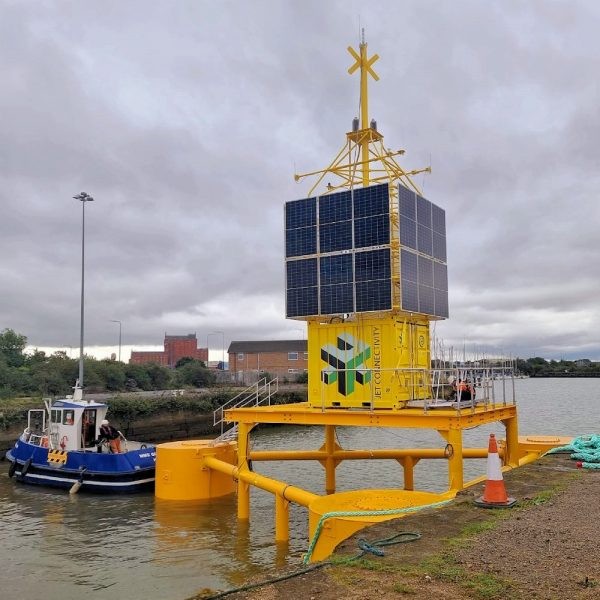JET Launch World’s First Permanently Deployable Floating 5G Base Station in UK

Bromsgrove-based JET Connectivity, which was spun out from JET Engineering Services and develops 5G (wireless broadband) mesh communications for the marine environment, has launched the “world’s first permanently deployable 5G floating base station” (cell tower) in Grimsby to help connect an operational offshore wind farm.
The bespoke solar-powered base station (JET-5 Te Fiti), which is the product of 3 years of hard work from a team of now 25 people, stands 17 metres tall and has been designed to deliver long range 5G connectivity for a multitude of uses. But in this case, the focus is as an offshore wind farm-based testbed, which will be used to push the boundaries of digital operations through robotics and autonomy.
Offshore wind farms go through years of surveying, decision-making, construction and commissioning before becoming operational. However, for a large proportion of this time, mobile phone signals and broadband internet connectivity are not available due to the requirement of a stable platform and subsea fibre optic cables traditionally needed to run a network.
Advertisement
The JET-5 Te Fiti platform aims to solve this by utilising its own in-house designed and built 5G Radio Access Network (RAN) software and systems, and floating buoy hosting platforms, to provide a pop-up, solar-powered, fibre-less 5G network to offshore sites.
James Thomas, CEO and Founder of JET Connectivity, said:
“This launch of our first offshore network is testament to what hard work from an exceptional team can deliver, and I am so grateful of the effort and hours the team has put in, particularly in the final build the last few weeks.
I hope we can continue to make the maritime sector safer and more environmentally sustainable as we grow our deployments in the coming years. Features such as the reef cubes built into our mooring systems are small ways we can make a positive impact on our oceans above the core services we are offering and enabling with our ocean data hubs.”
In this particular deployment, JET is working with a consortium including Microsoft and the Offshore Renewable Energy (ORE) Catapult, funded by industry, the Greater Lincolnshire LEP and Innovate UK, to deliver a 5G testbed – at an operational windfarm – which can be utilised by companies developing and trialling offshore technology that will require resilient, high bandwidth connectivity, such as drones and autonomous vessels.
However, assuming the tests go well, then the technology could eventually also be used to help extend 5G connectivity across more sites and shipping on the ocean.
Mark is a professional technology writer, IT consultant and computer engineer from Dorset (England), he also founded ISPreview in 1999 and enjoys analysing the latest telecoms and broadband developments. Find me on X (Twitter), Mastodon, Facebook, BlueSky, Threads.net and Linkedin.
« New Vodafone UK Broadband App Cuts Alexa from WiFi Booster























































Cool. But the solar panels appear to be oddly positioned.
The problem is that the sea is not a stable surface and so positioning is very much a dynamic challenge, which is in constant flux. As such, there’s a limit to what you can do, and it’s more important to be robust (fewer moving parts). Plus this is a trial, rather than the final model.
If you mean the vertical solar panel orientation, it’s probably optimized for low winter sun altitude (and water run-off).
Glad to know the north sea will see a better mobile signal than I do… (in a town – 4G – what’s that?)
Looks like it will certainly help windfarms! Really great solution to an age old problem!
Do we really need 5g out at sea? If it’s only operational data to see if things are turning and what power is being generated, LoRaWAN can happily travel 10-20km with a good antenna and line of site to the shore…
How does it get backhaul? Do these things mesh together?
Complicated but puts a whole 5G gNodB at sea.
“internet connectivity are not available due to the requirement of a stable platform”
Not true, Oil and Gas platforms use fast switching (300nS) electronicall steered antenna to get 150-300Mbps offshore. >12 to 15km with no problem in gale force winds.